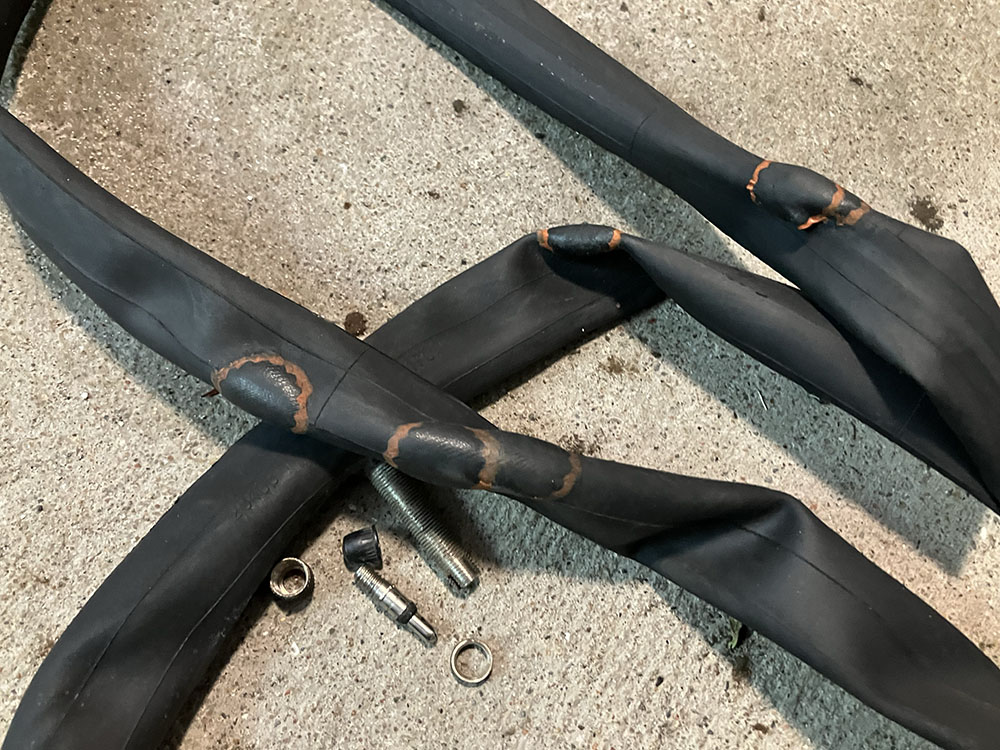
Should’ve gone for seven patches.

Cinematic/tech artist & filmmaker. Online since 1999.
Toast Note: Happy birthday to my sister Becky, who is celebrating in India. Wow. That is way cooler than a Cuisinart.
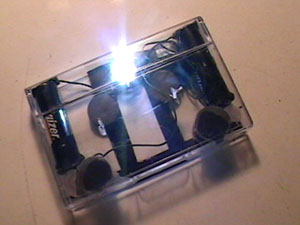
Boring Preface: Massachusetts state law requires a bike to have a forward light while riding at night. Commuting home on the city’s lit streets, I’m less worried about seeing the road than about other people seeing me. The cheapest bike lights seem to run about $20, so I’ll make that the maximum budget for this project. The light needs to be easy to attach and remove, durable enough to throw into a shoulder bag, and easy to turn on and off. I’d also like it to double as a flashlight the next time a transformer blows up in Central Square.
Theory: The front reflector seems to be the most logical place to attach the light to the bike, though I don’t want to obscure the reflector itself. It should be possible to build a bike light inside an old audiocassette case using two AA batteries, a pack of magnets, and a bright white LED upgrade for a mini Maglite. The light would clip around the bike’s front reflector. This project should cost less than $20.
Get:
Make sure that the cassette case isn’t one of the newer “slim” cases, but the regular kind. The mini Maglite upgrade kits consist of a replacement reflector housing three bright white LEDs wired into a resistor correctly sized for two AA batteries. They retail for about $11. You could certainly use your own LEDs (I read that Christmas lights are a cheap way to get them) but I don’t know nearly enough of a damn about electricity to figure out what size resistor to use — just that I need one to keep from blowing the LEDs out. Three-quarter inch ceramic (black) magnets usually come in packs of eight at the hardware or hobby store, and go for about $1.25. They’re fun to play with. If you don’t have a little spool of insulated wire lying around the house, I guarantee you have a broken stereo in the basement you can pillage. Utility knives seem to have been renamed “box cutters” since I was a kid, but I refuse to let the terrorists win.
Step A: Measure the width of your front reflector. These instructions are written for a reflector about 2 and 1/8 inches wide. From what I can tell from a cursory look around Porter Square, this kind is fairly common. Some of the newer bikes have smaller reflectors (why?), which should work fine for our project. A larger reflector would require a larger case — maybe a VHS-C tape case. Everything jams in pretty snugly with this design as is, so if your reflector is a different size you’ll have to play jazz a bit.
Step 1: Take the tape and label out of your audiocassette case and throw them away. Your crappy Sony deck hasn’t worked for most of a decade now anyway.
Step 2: Cut/snap the two prongs out of the tape case.
Step 3: Measure the width of the bracket on the back of your reflector — the part that connects it to the bike. Mine is 3/4 of an inch wide. The metal piece will probably be a little bit narrower than the part it screws into. If it is, just take the wider of the two measurements. Like I said, mine seems to be a pretty standard part, so if your reflector is the same size as mine it’s also probably 3/4 of an inch wide at the bracket too.
Step 4: Cut a notch, using that measurement, in the back of the tape case. The reflector and bracket together are too thick for the case to snap shut around, so we’ll need the bracket to hang out the back. Be careful to center your cut. Cut from the bottom of the case up to about even with the overhang. Mark your cut lightly with a straight edge or ruler, then go over it repeatedly until you cut all the way through. A little bit of splintering around the cut is normal, just don’t be so impatient that you crack the case. Did I mention it might be a good idea to put a new blade in your knife for this project? It might be a good idea to put a new blade in your knife for this project. Before now.
Step 5: Wrap electrical tape around all three sides of the cut. This will cover up the shattery bits, keep any cracks from spreading, and give it a nice rubberized mounting around the bike reflector bracket. Cut away the excess.
Step 6: Grab two of the ceramic magnets. We’re going to be gluing them on either side of the cut, about even with the overhang. These will be to rest against the back of the reflector, hopefully keeping it from moving too much. One by one — and with the other magnets clear — put a good bead of super glue on one of the two magnets, press it into place and hold it there for about a minute.
Step 7: Stick a piece of electrical tape along the entire length of the bottom of the case, folded over lengthwise. Half of it should be stuck to the outside of the case, and half to the inside, with the tape stuck to itself where it crosses the notch we cut. This will keep the bottom from wobbling by holding it tightly against the metal bracket. The electrical tape is a little bit stretchy, which is good. Anyone going for extra credit here might try sticking a rubber elastic inside the tape for extra holding power.
Step 8: Open the LED upgrade kit. You’ll find a little black cup with the LEDs inside and two wires sticking straight out the back, surrounded by a silver reflector.
Step 9: Remove the reflector; the LEDs are bright and directional enough without it, and it’s too thick to fit inside our tape case.
Step 10: Bend the two wires on the back to either side, being careful not to rush and snap them. I don’t really know how much abuse they’ll take, and I don’t want to find out.
Step 11: Cut four pieces of wire: three long ones (maybe 4-5 inches apiece?) and one short one (1-2 inches long).
Step 12: Strip each of the wires half an inch in from both ends. If you’ve never stripped wires with pliers before, it’s easy: Go around the wire worrying the plastic insulation with your pliers’ cutters. Don’t squeeze hard enough to actually cut the wire. The plastic cuts more easily than the metal inside. Begin pulling the wire as you continue weakening the insulation. Look for strong places, and keep pulling the wire and worrying at the insulation. Eventually, the plastic will begin to slide off the wire. Yank it off, and give the wire a twist or two.
Step 13: Take two of your longer pieces of wire. Make a little loop in the stripped portion on one side. Slide this loop around one of the wires on the back of the LED cup. Twist it a few more times, and squish it all together to get a good electrical connection. Repeat, looping the second wire to the cup’s other connection. If you want now, you can solder the wires permanently together — but I hate soldering, and I don’t want to pretend this project requires it. Either way, finish by sticking a square of electrical tape on the back of the cup.
Step 14: Slide the LED cup up under the lip of the cassette case, facing outward. Feel free to glue it in place, but it’s a pretty tight fit — I say don’t bother.
Step 15: Since LEDs only allow current to flow through them in one direction, we’ll need to figure out which side is + and which is -. Hold the wires against either end of one of the AA batteries. If it lights up (cool!) make a note of which side is which. If not, reverse and retry. (If nothing lights up, redo those connections.)
Step 16: Tear off two pieces of electrical tape, each about twice the length of a battery. Lay each strip of tape face up on the table and center the batteries on them. We’re going to be taping the wires directly to the batteries. It’s easy to do, and with the LEDs we won’t have to change the batteries much anyway.
Step 17: Tear off two small scraps of aluminum foil. Stick the wire from one end of the LED cup to the electrical tape beneath the battery contact, and then put a scrap of foil on top of it. Wrap the tape around the battery contact. Repeat for the other wire and the other battery. Wrap the tape around the battery contact. The aluminum foil is here to give us a larger electrical contact. Aluminum foil is conductive.
Step 18: Tear off two more scraps of aluminum foil. Using the same procedure as the last step, stick the short wire to the other end of one of the batteries. Grab a ceramic magnet and the other scrap of aluminum foil. Tape the loose end of the short wire to the top of the magnet, with part of the foil sticking out. Fold the foil over the top of the magnet.
Step 19: Tear off a larger scrap of aluminum foil and wrap it completely around one of the remaining magnets. This will be our “switch.”
Step 20: As in step 18, tape the remaining long wire to another of the magnets, with a piece of foil folded over to make an electrical contact. Let it stick itself to the “switch” magnet.
Step 21: Just like in step 17, connect the loose end of the wire to the remaining battery contact. The LED should light up. If it doesn’t, troubleshoot: We should have a circuit going from the LEDs to the first battery, through the bottom magnet, through the foil on the “switch,” through the second battery, back into the LEDs. Make sure your +’s and -‘s are all going in the right direction. Redo the foil/wire connections with more foil. If it did work, great job.
Step 22: Notice something. When you pull the “switch” magnet out of the stack and replace it with a bare magnet, the LEDs don’t light up. Ceramic magnets aren’t conductive. When the “switch” is in place, the circuit is on. When there’s a bare magnet there instead, it’s off. Leave the bare magnet in the stack between the two wired magnets. Stack the “switch” and the two remaining magnets with the “switch” in between. We should have two stacks of three magnets, which you’ll notice are about the same depth as the tape case.
Step 23: Push the two batteries tightly into the top right and left hand corners of the tape case so that they’re square with the edge.
Step 24: Place the stacks of magnets at the lower inside corners of the batteries. Experiment with closing the tape case. Find the position where the stacks are as close to the lower right and left hand corners of the case as possible, but the case can still close without hitting the magnet stacks or the batteries. We want everything to fit snugly.
Step 25: Once you’ve found the ideal positions, put a generous bead of super glue on top of each magnet stack and close the case. Hold the case shut as tightly as possible for about a minute, to make sure the super glue sets up properly with the top of the case.
Step 26: Flip the case over and repeat step 25, gluing the bottom of the magnet stacks to the bottom of the case.
Step 27: Once you’ve given the super glue some time to set up, flip the case back over and reopen it. Since we had to cut that notch in the back of the case, the back is the weak point: pull evenly on both sides to reopen.
Step 28: The trouble with ceramic magnets is that they don’t like sticking to anything more than they like sticking to themselves. To add strength, encircle each of the glued magnets with another bead of super glue. Let it set up, and cut away the excess if it gets on anything else.
Step 29: Tape the loose wires out of the way. You’re done. Swap the “switch” with the other loose magnet (storing the loose magnet on the other stack) place it around your bike reflector and let it snap shut. You’ve got a light on your bike — a bright one at that, which doesn’t strobe, pops on and off easily, and won’t chew through batteries every couple weeks.
Criticisms: Despite being built in a plastic case, the light is far from waterproof. I wouldn’t even call it terribly splashproof. Silly as it would look, a sandwich bag over the top might not be the worst idea on a rainy day. Opening the light takes some learning, as you figure out how to evenly pull on both sides of the case’s back. The biggest problem I’ve encountered, though, is the one mentioned in step 28: ceramic magnets just don’t like to glue down. Step 28 was an afterthought, after I had to reglue one of the stacks. It’s certainly stronger with an additional bead running around the base of the magnets, but I’m starting to think a gel epoxy (nasty as that stuff is) might eventually be needed.
Final Thoughts: It works, weirdly enough. Assuming you already have things like pliers, electrical tape and a set of batteries, you should have no trouble beating the $20 budget. (If not, they’re good things to own.) Please enjoy your antiluxury good. Build one? Send me a picture.
If you liked this project, you may also dig the previous Build Notes: Junk Mail Blinds.
[Click here for a printable version — or just turn stylesheets off.]

Boring Preface: There’s this idea of “junk chic” floating around that I’m vaguely attracted to. Most of it, however, seems to be concerned with buying old crap at antiques stores and putting a new coat of paint on it. What I’m interested in is more finding uses for the reasonably well-made things we’re expected to throw away. Somehow I’m not sure if making things yourself will ever come back into the mainstream; there’s just too much money to be made selling us everything. Maybe that’s the point. Free software, free instructions, free knowledge… There’s a growing, silent acknowledgment that there needs to be a non-commercial sphere to life, distinct from religion and opposition, and this nebulous idea of “family” our politicians keep pounding us with. Not everything is about money. The irony is that the people who sent me the raw material for this project did so in the hope of making money from me. And they can screw.
Theory: By affixing strips of junk mail to an existing set of venetian blinds, one can drastically reduce the amount of light allowed through without losing the ability to raise and lower the blinds.
Get: In my case, about three months’ worth of junk mail, but your mileage will vary. Your trusty roll of duct tape (color to suit). Two rolls of scotch tape. A ruler. A spool of uninsulated wire. A pair of needle-nosed pliers. A thumbtack. Space to work.
Step i: Measure the width of your window. The real width. Don’t leave a full inch on either side like those goddamn blinds we’re covering over. Leave maybe a couple of millimeters. (Dark! We must have dark!)
Step ii: Tape off on your workspace a piece of real estate (in my case, floor) measuring the same width as your window and six inches tall. (Or three floorboards, if they’re each two inches tall.) This will serve as a template for building the sections.
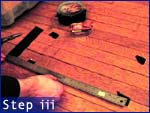 Step iii: Next we’ll need to figure out where to affix the hangers that will connect the junk mail blinds to the existing ones. We will eventually be bending wire into a set of three connector pieces, one for each of the three strings running down through the original blinds. For now, grab your ruler and measure the distance between the edge of the window and the nearest of these strings. On your template, go in the measured distance from either side and make tape marks. Also, find the center of the template and mark it with tape as well. I think we’re ready to start building a section.
Step iii: Next we’ll need to figure out where to affix the hangers that will connect the junk mail blinds to the existing ones. We will eventually be bending wire into a set of three connector pieces, one for each of the three strings running down through the original blinds. For now, grab your ruler and measure the distance between the edge of the window and the nearest of these strings. On your template, go in the measured distance from either side and make tape marks. Also, find the center of the template and mark it with tape as well. I think we’re ready to start building a section.
 Step 1: Find a nice piece of junk mail (you’ll start talking like this) — maybe a credit card letter with your name misspelled, or a useless “newsletter” from your predatory health insurance company. Lane Bryant sure likes sending me fliers now that they’ve decided I’m female. Whatever you have handy.
Step 1: Find a nice piece of junk mail (you’ll start talking like this) — maybe a credit card letter with your name misspelled, or a useless “newsletter” from your predatory health insurance company. Lane Bryant sure likes sending me fliers now that they’ve decided I’m female. Whatever you have handy.
 Step 2: Fold the piece of junk mail upward at the bottom (I recommend using an existing fold) and align it with the bottom left corner of your workspace.
Step 2: Fold the piece of junk mail upward at the bottom (I recommend using an existing fold) and align it with the bottom left corner of your workspace.
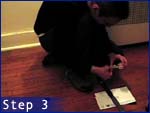 Step 3: Tape the folded portion down with scotch tape.
Step 3: Tape the folded portion down with scotch tape.
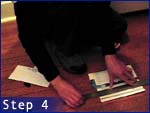 Step 4: Fold the top of your sheet of junk mail down so that it fits within your six-inch template. Chances are it doesn’t have another crease already made at the six inch mark, so use your ruler to make the fold yourself.
Step 4: Fold the top of your sheet of junk mail down so that it fits within your six-inch template. Chances are it doesn’t have another crease already made at the six inch mark, so use your ruler to make the fold yourself.
Step 5: Tape that bad boy down.
 Step 6: Grab another piece of junk mail. Place it under the previous piece so that they’re overlapping by an inch or two.
Step 6: Grab another piece of junk mail. Place it under the previous piece so that they’re overlapping by an inch or two.
 Step 7: Fold the bottom up so that it’s sort of “eating” the previous piece.
Step 7: Fold the bottom up so that it’s sort of “eating” the previous piece.
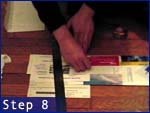 Step 8: Tape the folded part to the old piece and to itself. Be sure that the corners are taped thoroughly.
Step 8: Tape the folded part to the old piece and to itself. Be sure that the corners are taped thoroughly.
 Annoying Tip: Kinda thin? Not sure it’s going to block enough light? I’m sure you’ve got a lot of little pieces of junk mail floating around. Why not tape one of them inside the fold before taping it down? Envelopes work great for this — they’re two-ply. You can even stick smaller annoying things like fake credit cards inside the envelopes before taping them down.
Annoying Tip: Kinda thin? Not sure it’s going to block enough light? I’m sure you’ve got a lot of little pieces of junk mail floating around. Why not tape one of them inside the fold before taping it down? Envelopes work great for this — they’re two-ply. You can even stick smaller annoying things like fake credit cards inside the envelopes before taping them down.
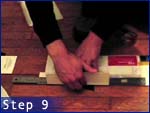 Step 9: Grab your ruler again and fold the top down.
Step 9: Grab your ruler again and fold the top down.
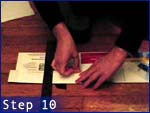 Step 10: Tape that muthah down, and to the previous piece.
Step 10: Tape that muthah down, and to the previous piece.
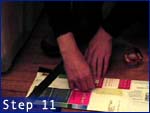 Step 11: Repeat steps 6 through 10 until the section fills your template. You now have a strip of junk mail six inches tall, and as wide as your window.
Step 11: Repeat steps 6 through 10 until the section fills your template. You now have a strip of junk mail six inches tall, and as wide as your window.
 Step 12: Enjoy a good pull of Endurance Ale. You’ve earned it! (It’s called Endurance for a reason, but it grows on you.)
Step 12: Enjoy a good pull of Endurance Ale. You’ve earned it! (It’s called Endurance for a reason, but it grows on you.)
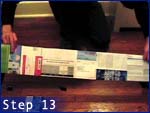 Step 13: Flip the section over. You’ll notice that all the taping has been done on the reverse, keeping it out of sight. Just because we’re making things out of junk mail doesn’t mean we can’t pay attention to aesthetics.
Step 13: Flip the section over. You’ll notice that all the taping has been done on the reverse, keeping it out of sight. Just because we’re making things out of junk mail doesn’t mean we can’t pay attention to aesthetics.
 Step 14: Grab your duct tape. We’ll be using the duct tape to add strength where the new blinds connect to the old ones. It’ll also impose some kind of order on the appearance of the blinds, which is probably just as well.
Step 14: Grab your duct tape. We’ll be using the duct tape to add strength where the new blinds connect to the old ones. It’ll also impose some kind of order on the appearance of the blinds, which is probably just as well.
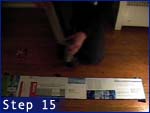 Step 15: Rip off a strip between half again and twice the height of the section. That’ll be about ten inches, if you want to measure it.
Step 15: Rip off a strip between half again and twice the height of the section. That’ll be about ten inches, if you want to measure it.
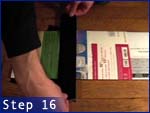 Step 16: Use the marks you made in step iii to stick the tape down where it will be needed to match up with the string.
Step 16: Use the marks you made in step iii to stick the tape down where it will be needed to match up with the string.
 Step 17: Flip the section back over.
Step 17: Flip the section back over.
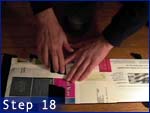 Step 18: Fold the ends of the strip of duct tape over and stick them down. Remember, we don’t care too much what this side looks like.
Step 18: Fold the ends of the strip of duct tape over and stick them down. Remember, we don’t care too much what this side looks like.
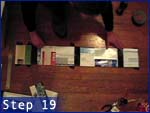 Step 19: Repeat steps 13 through 18, placing a strip of duct tape for each of the three marks we made in step iii.
Step 19: Repeat steps 13 through 18, placing a strip of duct tape for each of the three marks we made in step iii.
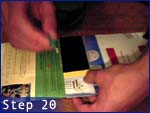 Step 20: Grab your thumbtack. On each of the strips of duct tape, make two holes about a quarter of an inch apart and one inch from the top of the section. I recommend cutting out a template, to save you from having to measure the position of the holes every time. Make sure the holes go all the way through, and are wide enough to get a piece of wire through. Don’t stab yourself.
Step 20: Grab your thumbtack. On each of the strips of duct tape, make two holes about a quarter of an inch apart and one inch from the top of the section. I recommend cutting out a template, to save you from having to measure the position of the holes every time. Make sure the holes go all the way through, and are wide enough to get a piece of wire through. Don’t stab yourself.
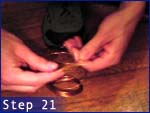 Step 21: Grab your spool of wire. Straighten a bit of it out to work with.
Step 21: Grab your spool of wire. Straighten a bit of it out to work with.
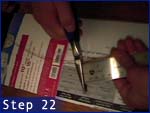 Step 22: Using your ruler and pliers, snip off three pieces of wire each measuring four inches long.
Step 22: Using your ruler and pliers, snip off three pieces of wire each measuring four inches long.
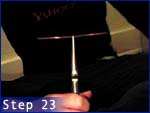 Step 23: Center a piece of wire in your pliers.
Step 23: Center a piece of wire in your pliers.
 Step 24: Fold it in half, into a long horseshoe shape.
Step 24: Fold it in half, into a long horseshoe shape.
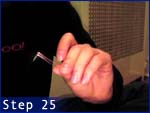 Step 25: Fold the wire at a right angle, half an inch from the pronged end.
Step 25: Fold the wire at a right angle, half an inch from the pronged end.
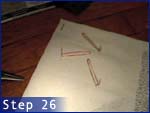 Step 26: Repeat steps 23 through 25 for the other two pieces of wire.
Step 26: Repeat steps 23 through 25 for the other two pieces of wire.
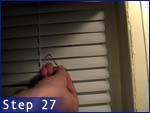 Step 27: Twist your venetian blinds shut so that the slats are angled down toward you.
Step 27: Twist your venetian blinds shut so that the slats are angled down toward you.
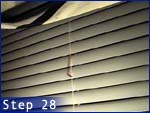 Step 28: Insert the first of the bent pieces of wire around the first string on the inside of your blinds. We want it to hang so that the prongs are facing inward.
Step 28: Insert the first of the bent pieces of wire around the first string on the inside of your blinds. We want it to hang so that the prongs are facing inward.
Step 29: Repeat step 28 for the other two pieces of wire.
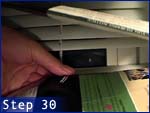 Step 30: Bring the blind section over to your window and find the first set of holes in the top of the duct tape.
Step 30: Bring the blind section over to your window and find the first set of holes in the top of the duct tape.
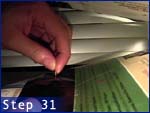 Step 31: Place the first prong through the first hole.
Step 31: Place the first prong through the first hole.
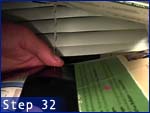 Step 32: Place the second prong through the second hole.
Step 32: Place the second prong through the second hole.
 Step 33: Reach around behind the section and bend the prongs up, flush with the back of it.
Step 33: Reach around behind the section and bend the prongs up, flush with the back of it.
 Step 34: Repeat steps 31 through 33 for the other two pieces of wire. The new junk mail blind section is officially hung.
Step 34: Repeat steps 31 through 33 for the other two pieces of wire. The new junk mail blind section is officially hung.
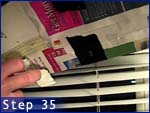 Step 35: Tear off three small squares of duct tape.
Step 35: Tear off three small squares of duct tape.
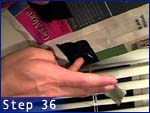 Step 36: Stick each over one of the exposed sets of prongs on the back. This is to keep the ends of the wire from catching on anything. Squeeze tight.
Step 36: Stick each over one of the exposed sets of prongs on the back. This is to keep the ends of the wire from catching on anything. Squeeze tight.
Step 37: Repeat all numbered steps until the blinds are complete.
Criticisms: I’ve noticed two things, since completing the blinds, which deserve attention. First, the mechanism in the blinds, not being designed to hold this much weight, has begun to squeak a bit. A dab of electric shaver oil or graphite would probably take care of the problem, but I haven’t bothered to try yet. The second concern is a tendency I’ve noticed for the lowermost sections to catch momentarily while nearing the bottom. Why this should be an issue near the bottom but not the top I still don’t know. I’ve found that the problem can be reduced by bending the wire hangers outward on the bottom-most sections, so that the blind section sits farther out from the original slats.
Final Thoughts: It took me about twenty minutes to do a section, once I got all of the experimenting out of the way. I did one or two sections a night, which made for some relaxing non-computer work before bed. (It was kinda nice.) I’m still not totally satisfied with the hanging scheme (bent wire) but I haven’t come up with anything better or easier. All things considered, I’m pretty happy.
